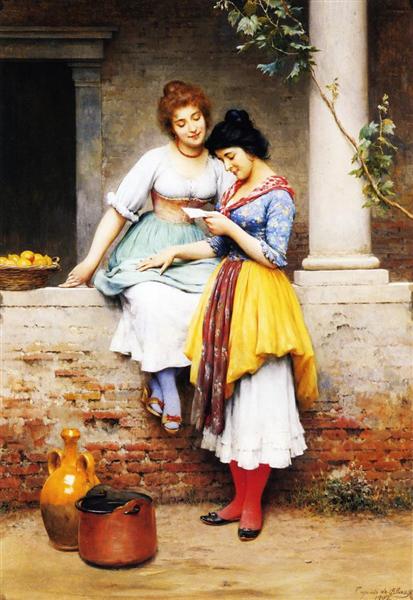Art Elements Assignment-The Love Letter
Background
This piece is called The Love Letter, by Eugene de Blaas. It was painted in 1902, and, although there is no specific location attached, this artist specialized in painting scenes of Venice. Most of his artwork is focused on "period pictures of Venitian culture," (The Worlds Artist) which leads me to believe that's where this painting was created. I couldn't find a specific background related to this piece, so all I can say with confidence is the time and place it represents.
From a more general perspective, I really enjoy this piece of art. I think it's something I would own. It's very beautiful, and matches the cottage aesthetic that I would like my future home to have. It gives me a sense of inner calm. The two women seem quietly intimate, and most of all at peace. The colors are subdued yet expressive, and there are no harsh lines that disrupt tranquility.
Analysis
There are multiple elements that contribute to my enjoyment of this piece. All information about art elements has been taken from artyfactory.com.
First, I am very attracted to this pieces use of tone. Tone is the use of light and dark shades in order to add depth to a piece. Blaas has mastered the use of tone in The Love Letter. Some places where this is particularly noticeable to me is the gradient that makes up the brick patterns and the doorway. This use of tone lends a very soft feel to the piece, as opposed to if the artist had chosen to use flat color with no dimension. It sets the entire emotion of the painting. This is a moment of sweet intimacy, not serious ponderance. If the color had been flat, the piece would have appeared sharper and more serious in nature.
Another element I would like to draw attention to is the use of texture. Texture is a physical sensation or the illusion of that physical sensation. In this painting, the brick is the most strongly textured item. It contributes contrast to the two women who are the subject of this piece. It makes the delicate lines, soft colors, and demure facial expressions all the more obvious. Without this backdrop of rough, broken down bricks, their delicacy may not be as apparent. Texture also heavily contributes to our interpretation of their personality. For example, look at their hair, which appears wispy and soft. If there was no stray hairs represented, if their hair was pulled into a tight, formed bun, or if it was gone altogether, we would likely interpret their emotions far differently.
Finally, the most alluring part of this for me personally is the artist's use of color. The background is wonderfully muted, which draws the eye to the subjects of the piece. Even the foliage, which in real life would likely be vibrant, is toned down so it does not distract from the two women in the center. Color acts in a very similar way to texture here, as it both draws the eye to the subjects of the piece, and gives us a hint to the girls personality.The girl on the left, because of her softly colored hair and clothing gives the viewer a sense of calm, and hints at a submissive nature. The pallet of the girl on the right is bolder. Her hair is dark black, with little dimension, and she wears a striking combination of yellow, red and blue. She stands in sharp contrast to her partner, who seems to melt into the background. Just from looking at it, we can tell the girl in yellow is stronger willed, and more outspoken then her companion.
Conclusion
The Love Letter is a beautifully composed piece, relying heavily on the elements of tone, texture, and color in order to convey the message of the painting. This is a story of soft romance, that stands out from the drab surroundings, and brings light to the world around it.
Sources
Artyfactory. “The Visual Elements.” Artyfactory, www.artyfactory.com/art_appreciation/visual-elements/visual-elements.html.
Blaas, Eugene de. “The Love Letter, 1902 - Eugene De Blaas.” Www.wikiart.org, 1 Jan. 1970, www.wikiart.org/en/eugene-de-blaas/the-love-letter-1.
The Worlds Artist LLC. “Eugene De Blaas Biography | Oil Painting Reproductions.” Eugene De Blaas Biography | Oil Paintings | The Worlds Artist, theworldsartist.com/artist/eugene-de-blaas.


Comments
Post a Comment